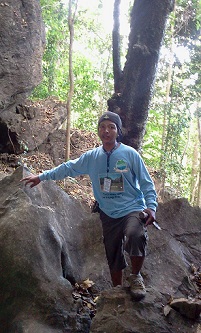WHERE once no one dared venture into the jungle of Lubang island that sheltered the World War II holdout 2nd Lt. Hiroo Onoda, it is now a favorite tourist destination in Mindoro Occidental.
Unaware that WWII had long ago ended, Onoda terrorized the islanders, fighting in the jungle for nearly three decades after the end of the Second World War. He grew into a near-mythical figure on Lubang island.
Children were warned against going into the forest because of the hapon. Farmers lost cattle and let fruit trees go unpicked because they did not want any encounter with Onoda, whose presence was announced with a rifle shot, but remained unseen.
His playground had been the mountain dividing the island’s Lubang and Looc municipalities in the northwest Philippines.
Today, villagers and visitors are given the opportunity to retrace Onoda’s steps through an 8-kilometer trail that covers the eight caves he had sheltered in during the 29 years that he waged a guerrilla war on the island, refusing to believe that Japanese forces had been defeated.
The former army intelligence officer came out of hiding and surrendered to his wartime commander in 1974 and went home to a hero’s welcome. He died in Tokyo last January 17 at the age of 91.
 The Onoda trail adventure begins with a two-and-a-half -hour boat ride from Calatagan in Batangas to the port in Tilik, Lubang island. There are three boats that ply the route, but Jupiter Express, which charges P500 pesos one way, is the only one that provides complimentary drinks and snacks to passengers.
The Onoda trail adventure begins with a two-and-a-half -hour boat ride from Calatagan in Batangas to the port in Tilik, Lubang island. There are three boats that ply the route, but Jupiter Express, which charges P500 pesos one way, is the only one that provides complimentary drinks and snacks to passengers.
From the port, one can hire a van or jeep to the town proper for P1,000. Few resorts are available. One called Michelle’s just at the back of the municipal hall, provides homey comfort at an affordable price.
The municipality charges a P2,500 documentation fee for trekkers. This is separate from the P300 per head the guide charges for tours. Peak season is from January to May when the weather is fair.
The Onoda trail, marked by an unimposing mango tree, begins after a 20-minute drive through a rough mountain road off the main highway. A thick forest cover protects the hiker from direct sunlight but it is still better to start early.
In the first few minutes, one is led through a gently sloping mountainside onto to a cabana built in the middle of a small clearing beside a brook.
“We can rest here,” said Rickson Tividad, a 28-year-old tour guide. “The next part will be more challenging,” said the native of the town, one of the original 19 guides employed by the Lubang government in 2010 when it opened the trail to tourists.
Like others on the island, Tividad has a personal connection to Onoda. His grandfather, Isaias Tanglao, was shot and wounded in the right thigh by Onoda.
Beyond the cabana is a steeper climb assisted by carved steps, crude handrails, and directional symbols that aid the hikers up three kilometers to Caves 1 to 3. These are well-hidden marble caverns where Onoda stashed his belongings while moving around the lush forest.
The shallow caves are elevated and well hidden from view, which would have provided Onoda a good cover to spot approaching locals without being seen. A natural tunnel connected cave 1 to Cave 2 but this has crumbled. Cave 3 is a little higher up in the mountainside and is still a nest for bats so tourists are advised against venturing inside.
 At this point the trail ends for the amateur trekkers. The next five kilometers is more rugged and advised only for serious mountaineers.
At this point the trail ends for the amateur trekkers. The next five kilometers is more rugged and advised only for serious mountaineers.
“If I were asked to escort tourists to the full trail, I’ll have to think about it,” chuckled Tividad.
The Onoda trail ends at the boundary of Lubang and Looc, where Onoda surrendered on March 9, 1974.
Farmer Resty Robles, 57, said he was among the local guides the Air Force contracted to escort them to Wakayama Point – now referred to as Pinagsukuan – where Onoda agreed to surrender.
The area, accessible after an easy half-hour walk past farms and three streams, is amply covered by coconuts and fruit trees. It is without a marker, stripped of its historical significance.
“Onoda first appeared from the bushes from the direction of the mountain. He had yellow teeth and he was bald. He was a small man but he looked strong and healthy,” Robles recalled.
He said a group of islanders milled behind coconut trees craning their necks to catch a glimpse of the hapon. In the crowd was a woman whose husband was among those shot and killed by Onoda. “She was clutching a rock. Maybe she wanted to hurl it at Onoda but she never got the chance,” he said.
Onoda and three companions, one of whom surrendered while the others were shot dead, were blamed for killing around 30 villagers while hiding in the remote island. Robles claims that he and his father had been shot at by Onoda once.
There was a high level of hostility towards Onoda at the time he surrendered. This emotion had given way to indifference among some of the islanders but when news of his death reached the island early this year, officials of Lubang sent their condolences to his family.
Onoda is part of the island’s history so it is no surprise that the municipalities of Lubang and Looc have embarked on a joint project to develop the Onoda trail as the centerpiece of the island’s tourism program.

